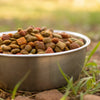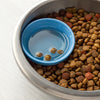How Much Dry Dog Food Do I Feed My Dog? A Comprehensive Guide for Pet Owners
- Houndsy
Table of Contents
- Introduction
- Understanding Your Dog's Nutritional Needs
- Feeding Guidelines: How Much Dry Dog Food for Your Dog?
- Choosing the Right Dog Food
- Monitoring Your Dog’s Weight and Health
- The Houndsy Kibble Dispenser: Simplifying Feeding Time
- Conclusion
Introduction
Did you know that approximately 59% of dogs in the United States are classified as overweight or obese? This alarming statistic underscores the importance of understanding how much dry dog food to feed our furry friends. As dedicated pet owners, we strive to ensure our dogs lead healthy, active lives, and proper nutrition is a cornerstone of that effort.
Feeding our dogs the right amount of food can be confusing, as it varies greatly depending on several factors including age, breed, size, and activity level. In this blog post, we will explore the intricacies of dog nutrition, helping you determine how much dry dog food to feed your dog, and provide practical tips to make feeding time a breeze.
By the end of this article, you will have a comprehensive understanding of the factors influencing your dog's dietary needs and how to create a feeding routine that supports their health and well-being. So, let’s dive in and reflect on our own pet feeding routines as we embark on this journey to optimize our dogs' diets.
Understanding Your Dog's Nutritional Needs
Factors Influencing How Much to Feed Your Dog
When it comes to deciding how much dry dog food to feed your dog, there are several key factors to consider:
- Age: Puppies, adults, and senior dogs have different nutritional requirements. Puppies generally need more calories and nutrients to support their rapid growth, while senior dogs may require fewer calories due to reduced activity levels.
- Size: Larger dogs typically require more food than smaller breeds. For instance, a Great Dane will need significantly more kibble than a Chihuahua.
- Activity Level: Dogs that are highly active or working dogs will require more calories than those that are more sedentary. If your dog enjoys long walks, runs, or playtime, they will need a higher caloric intake.
- Body Condition Score (BCS): Evaluating your dog’s body condition score can help determine if they are at a healthy weight. Overweight dogs may need to eat less, while underweight dogs may require additional calories.
- Health Status: Dogs with certain health conditions or those that are pregnant or nursing may need specialized diets or adjusted feeding amounts.
- Type of Dog Food: Different dog foods have varying calorie densities. Always consult the feeding guidelines on the packaging, as they provide specific recommendations based on the food's composition.
The Importance of Measuring Food
To ensure your dog is receiving the correct amount of food, we recommend using a measuring cup rather than estimating. This simple step can help prevent overfeeding or underfeeding, which are both detrimental to your dog's health.
Feeding Guidelines: How Much Dry Dog Food for Your Dog?
General Daily Feeding Recommendations
While feeding amounts can vary from dog to dog, here are some general guidelines based on weight and age:
- Puppies (0-4 months): Generally, puppies should be fed three times a day, with amounts varying based on their weight. For example, a 10-pound puppy may require about 2 to 3 cups of food daily, split into three meals.
-
Adult Dogs (1-7 years): Adult dogs typically eat two meals per day. Depending on their weight, they may require 2-4% of their body weight in food daily. For example:
- Dogs weighing 10-20 lbs: ¾ to 1 ⅓ cups
- Dogs weighing 30-50 lbs: 1 ¼ to 2 ⅔ cups
- Dogs weighing 60-100 lbs: 2 ⅔ to 4 ⅓ cups
- Senior Dogs (7+ years): Senior dogs often require less food due to a slower metabolism. Nonetheless, they should still be fed twice daily, with amounts adjusted according to their health needs and weight.
Feeding Chart: Daily Recommendations
Here’s a simplified feeding chart based on the weight of your dog:
| Weight of Dog (lbs) | Cups of Food per Day |
|---|---|
| 5-10 | ⅓ - ½ |
| 10-20 | ¾ - 1 ⅓ |
| 30-50 | 1 ¾ - 2 ⅔ |
| 60-100 | 3 - 4 ½ |
| Over 100 | 4 ½ + ¼ cup for each additional 10 lbs |
Use this chart as a starting point, but remember to adjust based on your dog’s specific needs.
How Often Should You Feed Your Dog?
Most adult dogs benefit from being fed twice a day, while puppies require more frequent meals—typically three to four times daily. Dividing your dog’s daily intake into smaller meals can help manage their energy levels and prevent overeating.
Choosing the Right Dog Food
Types of Dog Food
Understanding the types of dog food available can also influence how much to feed your dog. Here are the most common types:
- Dry Kibble: This is often the most convenient option. Kibble is less messy, has a longer shelf life, and can help maintain dental health. However, the calorie density can vary widely among brands, so it’s essential to check the feeding guidelines.
- Wet Food: Canned dog food can be more palatable for some dogs and provides added moisture. However, it often has a higher calorie density, so adjustments may be necessary.
- Raw Diet: Some pet owners opt for a raw diet, which can be nutrient-dense but requires careful planning to ensure a balanced intake of nutrients. Consult with your veterinarian before transitioning to a raw diet.
- Homemade Meals: Preparing homemade meals for your dog allows for control over ingredients but requires a thorough understanding of canine nutrition to avoid deficiencies.
Quality Matters
Regardless of the type of food you choose, prioritize high-quality ingredients. Look for products that list meat as the first ingredient and avoid those with excessive fillers, by-products, or artificial additives. Investing in quality dog food can lead to better health outcomes for your furry friend.
Monitoring Your Dog’s Weight and Health
Regular Check-ups
Regular veterinary check-ups are essential for monitoring your dog’s weight and adjusting their diet as needed. Your veterinarian can provide insights into your dog’s ideal weight and help you evaluate their body condition score.
Observing Changes
Be vigilant for any changes in your dog’s behavior or health. If you notice weight gain, lethargy, or changes in appetite, it may indicate that adjustments to their diet or feeding routine are necessary.
The Houndsy Kibble Dispenser: Simplifying Feeding Time
At Houndsy, we understand the challenges of maintaining a consistent feeding routine. Our flagship product, the Houndsy Kibble Dispenser, offers an elegant solution to everyday feeding challenges.
Features of the Houndsy Kibble Dispenser
- Convenient Crank: Our dispenser features a user-friendly crank at standing height, eliminating the need to bend down when serving food.
- Perfect Portion Control: With every turn, you can dispense the precise amount of kibble your dog needs, ensuring consistency and reducing waste.
- Stylish Design: The mid-century modern aesthetic complements your home decor while keeping feeding time organized.
- Large Storage Capacity: Holds 25-30 lbs of kibble, allowing less frequent refills.
- BPA-Free Liner: Keeps kibble fresh and safe for your dog.
By elevating the feeding experience, our dispenser not only enhances your home’s design but also encourages healthy eating habits. Explore our Houndsy Kibble Dispenser today!
Conclusion
Feeding your dog the right amount of food is crucial for their overall health and well-being. By considering factors such as age, size, activity level, and health status, you can create a tailored feeding plan that meets their unique needs. Remember to use a measuring cup and consult your veterinarian for personalized recommendations.
Incorporating high-quality dog food and monitoring your dog's weight will help prevent obesity and its associated health risks. And with the help of the Houndsy Kibble Dispenser, you can simplify and beautify your dog feeding routine.
Reflect on your current feeding practices and consider how you might implement these insights to enhance your dog’s nutrition. Invest in their health today for a happier, healthier tomorrow!
FAQ
How do I know if I'm feeding my dog enough?
The best way to determine if you are feeding your dog enough is to regularly monitor their body condition score and weight. Consult with your veterinarian for personalized recommendations.
How often should I feed my dog?
Most adult dogs should be fed twice a day, while puppies typically require three to four meals daily.
What should I do if my dog is overweight?
If your dog is overweight, consult your veterinarian to create a weight loss plan that may include dietary adjustments and increased physical activity.
Are there specific feeding guidelines for puppies?
Yes, puppies require more frequent meals and higher caloric intake to support their growth. Refer to a puppy feeding chart for guidance.
Can I switch my dog’s food suddenly?
It's best to gradually transition to a new dog food over 7-10 days to avoid gastrointestinal upset. Mix increasing amounts of the new food with decreasing amounts of the old food.
For more information on how our products can enhance your dog’s feeding experience, check out the Houndsy Kibble Dispenser today!












